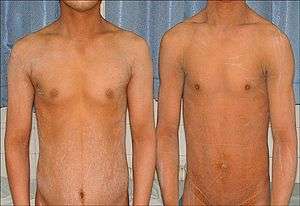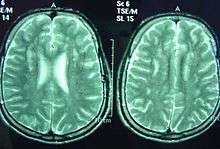Sjögren–Larsson syndrome
Sjögren–Larsson syndrome is a rare autosomal recessive form of ichthyosis with neurological symptoms.[1]:485[2]:564[3] It can be identified by a triad of medical disorders. The first is ichthyosis, which is a buildup of skin to form a scale-like covering that causes dry skin and other problems. The second identifier is paraplegia which is characterized by leg spasms. The final identifier is intellectual delay.
| Sjögren–Larsson syndrome | |
|---|---|
| Other names | SLS |
 | |
| Two brothers (21 and 25 years old) with generalized dryness of skin with fine scales mainly around the umbilicus and in the flexural folds, one of Sjögren–Larsson syndrome characteristics. | |
| Specialty | Medical genetics |
The gene of SLS is found on chromosome 17. In order for a child to receive SLS both parents must be carriers of the SLS gene. If they are carriers their child has a ¼ chance of getting the disease. In 1957 Sjögren and Larsson proposed that the Swedes with the disease all descended from a common ancestor 600 years ago. Today only 30–40 persons in Sweden have this disease.[4]
Signs and symptoms

- Dry and scaly skin similar to all other ichtyosiforms (types of ichthyosis).
- Neurological problems – this can often cause mild paralysis in the legs
- Mild to moderate intellectual disability.
- Often associated ocular features, which include pigmentary changes in the retina.
The usual presentation of crystalline maculopathy is from the age of 1-2 years onwards.
Causes
It is associated with a deficiency of the enzyme fatty aldehyde dehydrogenase (ALDH3A2) located on the short arm of chromosome 17 (17p11.2). At least 11 distinct mutations have been identified.[5]
This condition is inherited in an autosomal recessive pattern.
Diagnosis
Treatment
Eponym
It was characterized by Torsten Sjögren and Tage Konrad Leopold Larsson (1905–1998), a Swedish medical statistician.[6][7]
It should not be confused with Sjögren's syndrome, which is a distinct condition named after a different person (Henrik Sjögren).
See also
- Shabbir syndrome
- List of cutaneous conditions
References
- Freedberg, et al. (2003). Fitzpatrick's Dermatology in General Medicine. (6th ed.). McGraw-Hill. ISBN 0-07-138076-0.
- James, William; Berger, Timothy; Elston, Dirk (2005). Andrews' Diseases of the Skin: Clinical Dermatology. (10th ed.). Saunders. ISBN 0-7216-2921-0.
- Rapini, Ronald P.; Bolognia, Jean L.; Jorizzo, Joseph L. (2007). Dermatology: 2-Volume Set. St. Louis: Mosby. ISBN 978-1-4160-2999-1.
- "Sjögren-Larssons syndrom".
- Sillén A, Anton-Lamprecht I, Braun-Quentin C, et al. (1998). "Spectrum of mutations and sequence variants in the FALDH gene in patients with Sjögren–Larsson syndrome". Hum. Mutat. 12 (6): 377–84. doi:10.1002/(SICI)1098-1004(1998)12:6<377::AID-HUMU3>3.0.CO;2-I. PMID 9829906.
- synd/1678 at Who Named It?
- SJOGREN T, LARSSON T (1957). "Oligophrenia in combination with congenital ichthyosis and spastic disorders; a clinical and genetic study". Acta Psychiatr Neurol Scand Suppl. 113: 1–112. PMID 13457946.
Further reading
- Sjögren, K. G. Torsten; Larsson, Tage K. (1957). "Oligophrenia in combination with congenital ichtyosis and spastic disorders; a clinical and genetic study". Acta Psychiatrica et Neurologica Scandinavica. Copenhagen. 32 (supplement 113): 9–105. PMID 13457946.
External links
| Classification | |
|---|---|
| External resources |